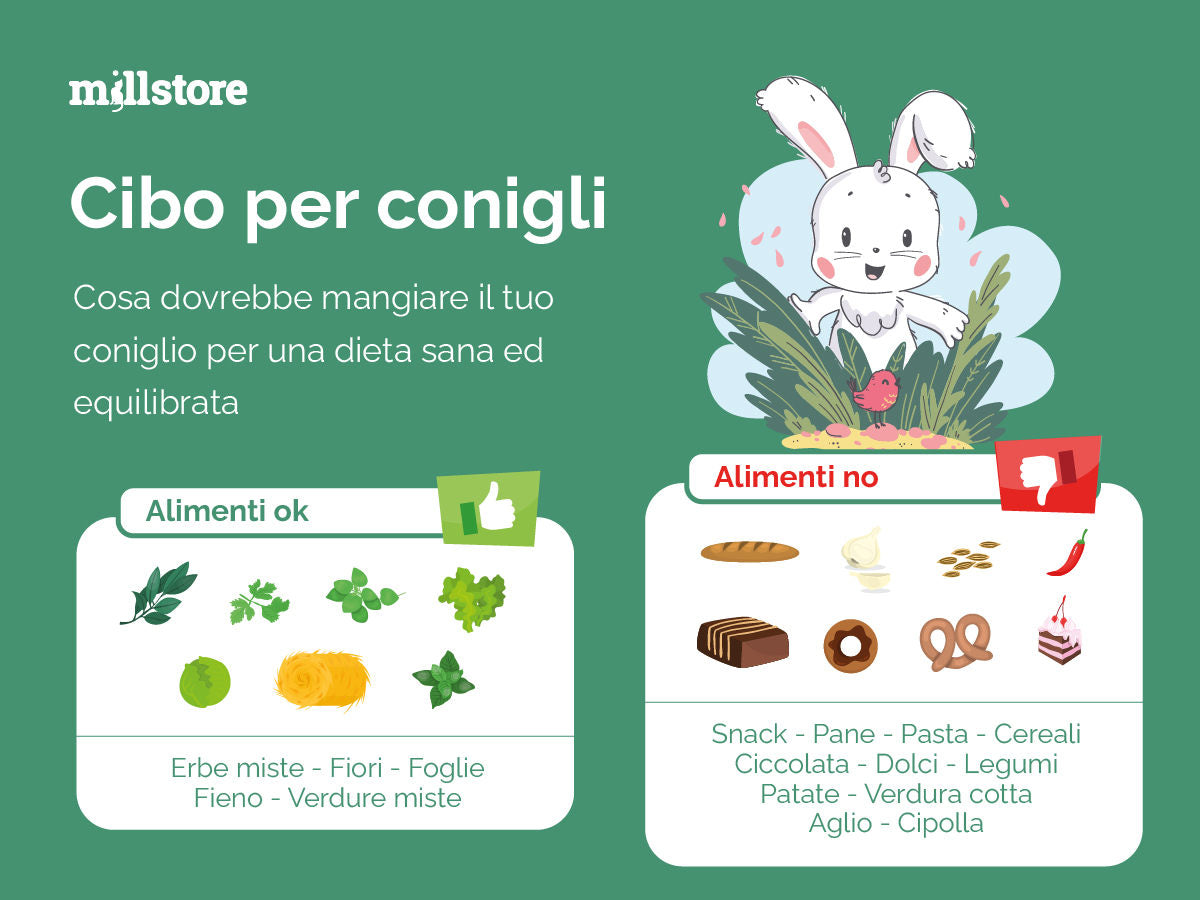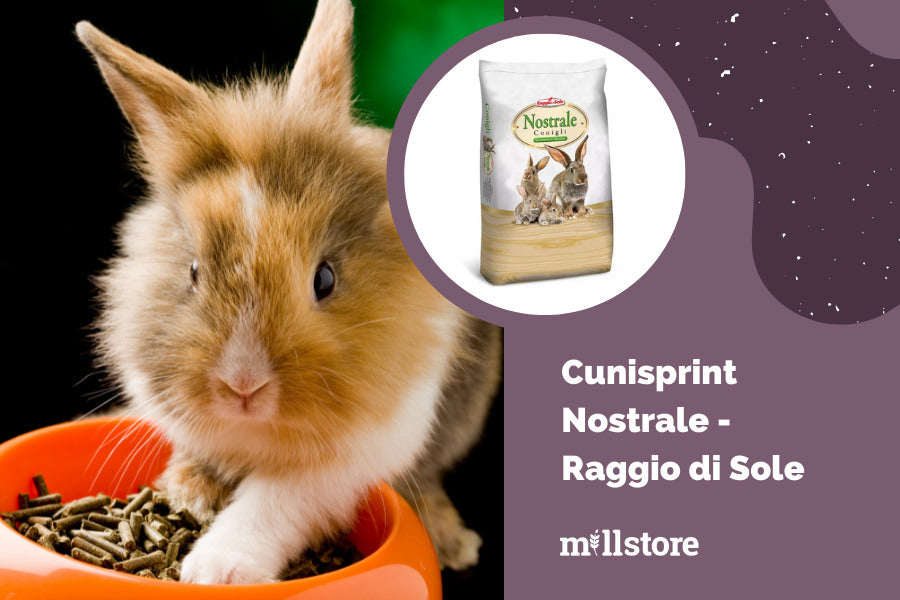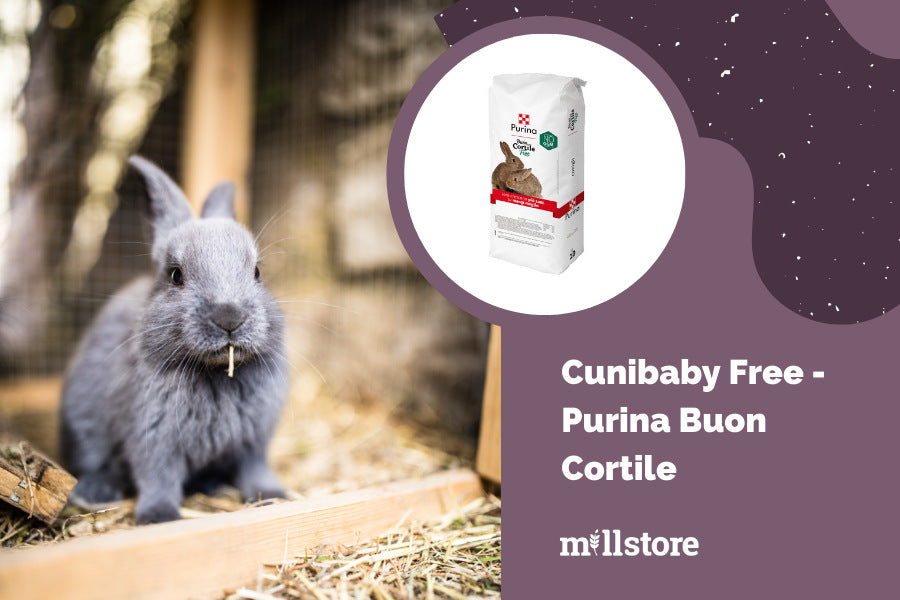If you asked a child, "What do rabbits eat?" the answer would definitely be: carrots.
In fact, these vegetables are an excellent food for them, but despite the fact that the rabbit is a strict herbivore , its diet is not as simple and obvious as in the collective imagination.
This is because it needs to integrate various elements, both to avoid health problems and to ensure the best reproductive results.
Whether you own a farm or have undertaken a livestock breeding business for your own consumption, you must be able to ensure the welfare of the animal up until the moment of slaughter.
For this reason, it is essential that you know what type of animal the rabbit is, the particularity of its digestive system and its nutritional needs based on the different stages of life.
In this article we will see:
How Rabbit Digestion Works
To understand what is the right diet for your rabbits, it is important that you first know the particularities of their digestive system.
Equipped with continuously growing teeth (pretty much like our nails), rabbits require foods rich in fibre that require a lot of chewing.
As already mentioned, the rabbit is an obligate herbivore because its digestive system is highly specialized for a diet rich in fiber (therefore mainly grass).
Unlike what happens physiologically in other animals, the most important part of its gastrointestinal tract is not the stomach (which acts as a sort of "warehouse" for food), but the cecum, where food digestion takes place.
In the rabbit's digestive system, two different types of feces are produced: the first are the classic hard and dry balls that represent the final result of digestion and that the animal normally abandons in the environment.
The second ones, called "cecotrophs", are more greyish in colour, soft, shiny and smell like hay. They are produced by the bacterial flora present in the cecum and, once expelled, are ingested again to be re-digested.
The cecotroph is very rich in nutrients such as vitamins, amino acids, mineral salts and fatty acids that its body is not able to synthesize on its own.
The peculiarity of the digestive system of rabbits means that, if you want to raise them successfully and with respect for their health and that of those who will consume their meat, you will have to pay close attention to their diet .
These lagomorphs are in fact extremely vulnerable to gastroenteritis which is very debilitating, harmful and often fatal.
Choosing a good quality rabbit food and always keeping fresh, clean water available is essential for maintaining the balance of the intestinal/caecal bacterial flora responsible for the production of the cecotroph and therefore for maintaining the animal's optimal state of health.
What to feed a meat rabbit?
In nature, the wild rabbit feeds mainly on wild herbs, roots and berries.
Even in traditional farms designed to meet the needs of a single family, rabbits tend to be fed hay, fresh fruit and vegetables.
A type of diet that is undoubtedly genuine, but which nevertheless presents disadvantages in terms of slower and non-homogeneous growth of the animals, considering that a farm rabbit has an average life of around three months .
For this reason and also for greater practicality, the advice is to use specific feed for rabbits.
The best ones generally come in the form of pellets, i.e. small cylinders of pressed hay, vegetables and herbs which have the characteristic of providing a homogeneous and balanced diet .
Administering a food of a certain hardness , such as pellets, will be essential to allow a physiological consumption of the teeth , avoiding their excessive development with potentially serious consequences on the animal's health.
Furthermore, the use of feed, unlike a diet based on forage and vegetables, prevents the animal from choosing the food that is most palatable to him, neglecting others to the detriment of a correct intake of the necessary nutrients.
If you have not considered the feed so far, also keep in mind that there are very dangerous food errors for the health of rabbits , the main ones being the excess of simple carbohydrates such as bread, cereals, lack of fiber, excess of moldy grass, forage or straw.
As for fresh fruit , if you really want to give it, do so only in limited quantities and no more than once a week .

How to choose feed for breeding rabbits
In addition to choosing the food for your rabbits from a serious and reliable retailer , by consulting the label , you will have to make sure that the product contains and reports these fundamental elements:
- A percentage of fiber of about 18-20%
- An indicative percentage of 14% protein, 0.6% calcium and 4% fat
- The indication of the animal's life stage for which it is recommended
As we have seen, due to the particular physiology of the rabbit's digestive system, fibre is a fundamental component of its diet .
In addition to producing energy, it helps regulate intestinal functions, avoiding disorders such as diarrhea and constipation.
Choosing a rabbit food that is suitable for the various life stages of your animals is another determining factor and means having correctly fulfilled more than half of the management obligations.
In fact, not only does the speed of fattening and the production of meat of your animals depend on their diet, but also the quality of the meat itself . Diet also influences the health status of rabbits.
For example, an adult male rabbit will have different nutritional needs than a gestating female.
Considering that newborn rabbits up to the second week of life feed exclusively on their mother's milk, we can distinguish three main phases in the life of a breeding rabbit: reproduction, growth and fattening .

Feed for the reproductive phase of rabbits
Reproduction is one of the most important stages in rabbit breeding.
As for all mammals, birth is followed by lactation, a very important and demanding period in terms of energy requirements .
To keep your breeding rabbits healthy, both during gestation and lactation , you will need to choose feeds specifically formulated to ensure a correct intake of energy and nutrients.
Such as, for example, the CuniSprint pelleted feed which, formulated with the best quality raw materials and fibre, allows you to feed rabbits in all stages of breeding and is particularly suitable for gestating and lactating mares .
It can be administered dry at will and without the addition of other foods to litters, mares and growing and fattening animals.
With the addition of a small amount of flaked cereals, in the last phase of the animal's life it contributes to obtaining better results in terms of tenderness and flavour of the meat.
CuniTutto Free feed is a pelleted feed rich in fibre, highly digestible and completely free of GMOs (genetically modified organisms).
It supports the nutritional needs of rabbits, doe and fattening animals by promoting milk production, optimal physical condition of the mares and correct muscle growth of the animals in the growth and fattening phase.

Feed for growing rabbits
The rabbits remain with their mother until they are approximately 35-40 days old . After 10-15 days they leave the nest and begin to benefit from a weaning feed that can be made available to them and administered dry and ad libitum, to rabbits starting from 10 days old and up to 40 days old .
The growth phase begins at weaning, lasts until approximately 60 days of age and precedes the finishing period.
It is one of the most demanding times for the young animal as during this period the rabbit reaches its maximum daily growth levels and therefore requires appropriately formulated foods.
Growth aims at the harmonious development of the animal's body structure to prepare it for fattening.
Cunibaby Free feed is a complete, GMO-free food for rabbits from the 15th day of life and is formulated with highly selected ingredients: an excellent balance of nutrients and complete vitamin and mineral integration .
In addition to promoting high growth performance, it contributes to the reduction of gastrointestinal diseases - to which rabbits are highly predisposed - and to the production of healthy and resistant litters.

Rabbit fattening feed
The fattening phase starts at around 60 days of age and ends at around 11-12 weeks, which represents the average life cycle of the meat rabbit.
The feed that you will have to provide to your animals during this period must be characterized by a high energy intake because they are aimed at achieving the typical characteristics of rabbit meat which is characterized by its high nutritional value, good protein intake and low sodium and cholesterol content.
Rabbit Flakes fattening feed is a pellet enriched with barley and corn flakes, crushed broad beans, carob and carrot and spinach extruders.
Highly palatable and easily digestible , it combines pellet technology with the naturalness and genuineness of cereals and vegetables.
It is particularly suitable in the fattening and finishing stages as it helps to give the meat tenderness, compactness and excellent flavour .
Can you recognize quality rabbit food?
It may seem trivial, but the first precaution you should take to be sure of purchasing quality rabbit food is to turn to a serious retailer who can support you in your choice if you are a novice.
Remember that the food you feed your pets will influence what you and your family eat.
Having made this necessary premise, let's recap, based on what has been said so far, here's how you can recognize a truly quality feed:
- Pay attention to the fibre content , which is essential to ensure the correct functioning of the rabbit's digestive system.
- Prefer pellet-type foods whose consistency is useful for wearing down the continuously growing teeth of this species.
- Choose specific products based on the life stage of the animals because they will be able to meet the nutritional needs that characterize each period.
- Make sure the feed does not contain substances harmful to the health of rabbits.
While nutrition undoubtedly represents a determining factor for the health of your rabbits and for the good performance of your breeding in terms of quantity and quality, there are other precautions that you must absolutely follow to avoid diseases, even fatal ones, especially affecting the gastrointestinal system:
- Never run out of clean, fresh water
- Provide your pets with adequate space for each head, avoiding overcrowding
- Ensure regular cleaning and disinfection of the places where you raise rabbits
- Keep animals (such as rats and mice) and insect pests under control. Mosquitoes, for example, carry a serious disease: myxomatosis.
If you are looking for the best rabbit feed for your farm and need information and useful advice , contact the Millstore experts : they will offer you all the assistance you need.


